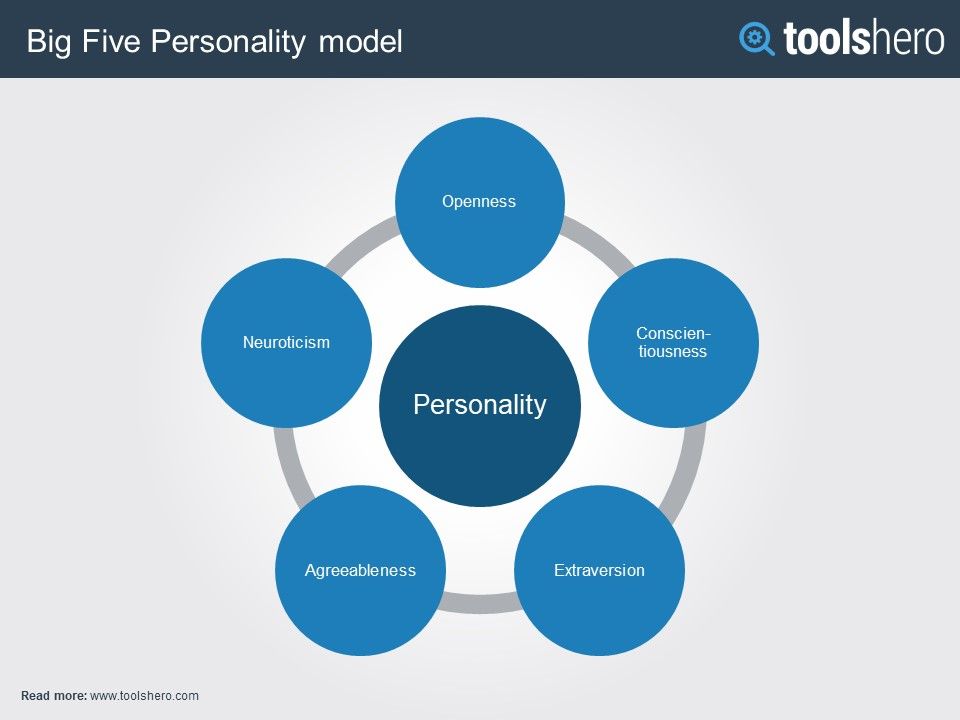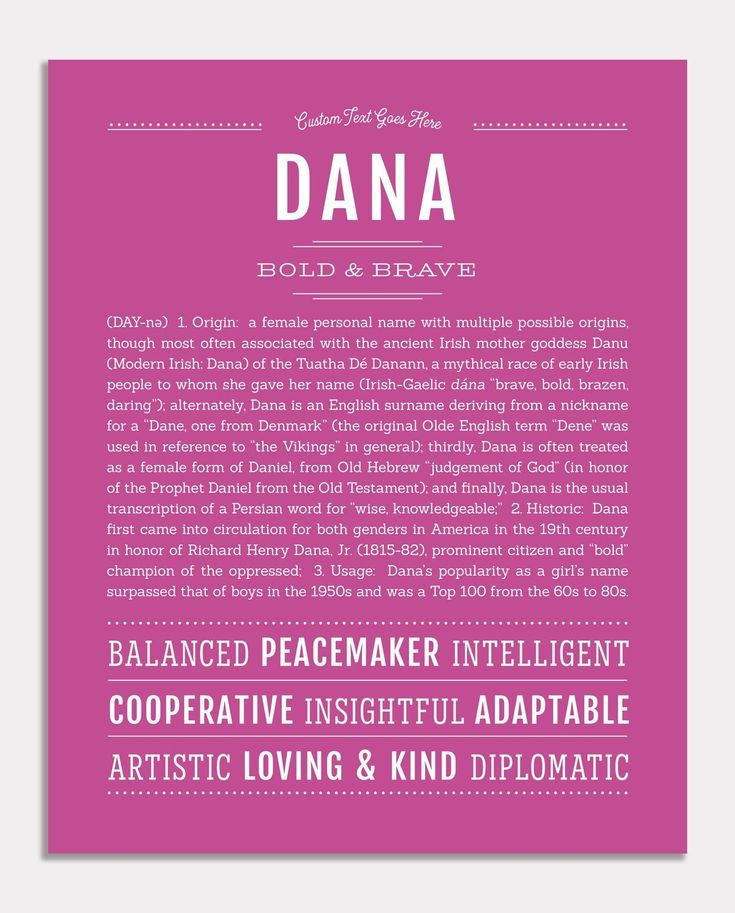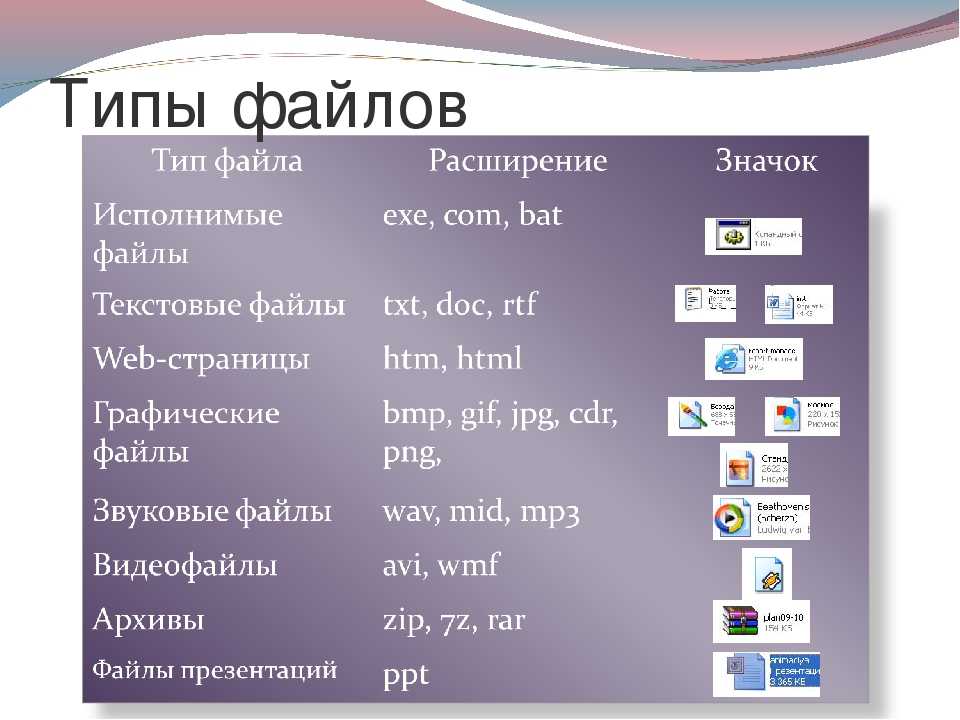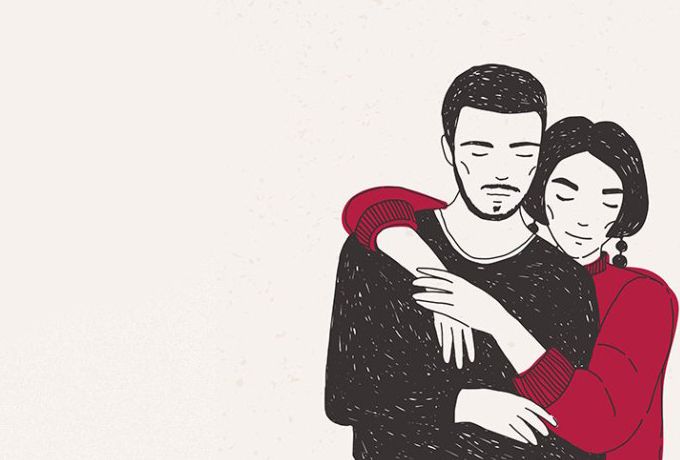Five types of personality
What Are The Big 5 Personality Traits?
Many modern and traditional studies in psychology point to 5 basic dimensions of personality. Evidence of this theory has grown over the years with the principle theory emerging in 1949. The five broad personality traits described by the theory are extraversion (also often spelled extroversion), agreeableness, openness, conscientiousness, and neuroticism.
The five basic personality traits is a theory developed in 1949 by D. W. Fiske (1949) and later expanded upon by other researchers including Norman (1967), Smith (1967), Goldberg (1981), and McCrae & Costa (1987).
Researchers had spent years before trying to pin down character traits as a way of analysing people’s behaviour. At one point, Gordon Allport found over 4000 traits. Even when this was reduced to 16 it was seen as too complicated. This is where the five big personality traits began.
These broad categories have been researched and developed over the years and, whilst there is extensive study into each area, researchers don’t always agree on the definition of each characteristic.
What are the big five personality traits?
Openness
Openness is a characteristic that includes imagination and insight. The world, other people and an eagerness to learn and experience new things is particularly high for this personality trait. It leads to having a broad range of interests and being more adventurous when it comes to decision making.
Creativity also plays a big part in the openness trait; this leads to a greater comfort zone when it comes to abstract and lateral thinking.
Think of that person who’s always ordering the most exotic thing on the menu, going to different places and having interests which you would never have thought of… that is someone who has a high openness trait.
Anyone low in this trait tends to be viewed with more traditional approaches to life and may struggle when it comes to problem solving outside their comfort zone of knowledge.
Conscientiousness
Conscientiousness is a trait that includes high levels of thoughtfulness, good impulse control, and goal-directed behaviours. This organised and structured approach is often found within people who work in science and even high-retail finance where detail orientation and organisation are required as a skill set.
A highly conscientious person will regularly plan ahead and analyse their own behaviour to see how it affects others. Project management teams and HR departments regularly have highly conscientious people working in their teams to help balance out the structural roles within the overall team development.
A good example of a conscientious person would be someone you know who is always planning ahead for the next time you meet - and in the meantime, regularly staying in contact, checking in on your wellbeing. They like to organise around certain dates and events and are focused on you when you meet.
People low in conscientiousness tend to dislike structure and schedules, procrastinate on important tasks and fail to complete tasks as well.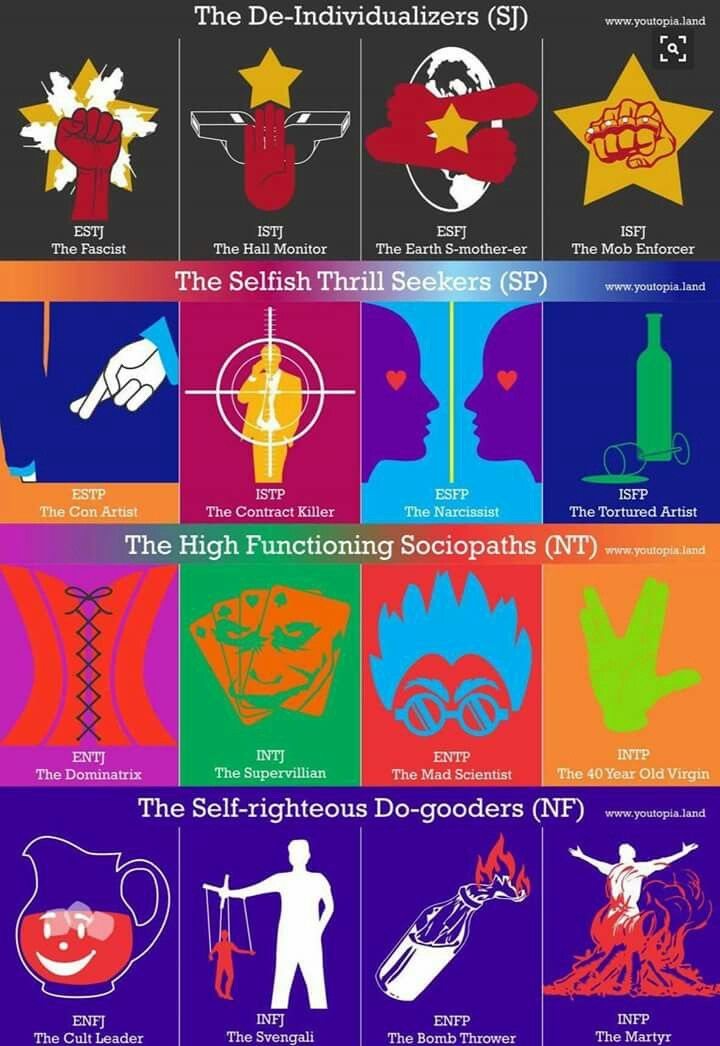
Extraversion
Extraversion (sometimes referred to as Extroversion) is a trait that many will have come across in their own lives. It’s easily identifiable and widely recognisable as “someone who gets energised in the company of others.”
This, amongst other traits which include, talkativeness, assertiveness and high amounts of emotional expressiveness, have made extraverted people widely recognisable over many years of social interaction.
We all have that one friend or family member - or several - who aren’t exactly wall flowers in a social interaction. They thrive on being the centre of attention, enjoy meeting new people and somehow tend to have the biggest friends and acquaintance group you have known.
The opposite is, of course, someone else in our lives we may know, an introvert. They prefer solitude and have less energy in social situations. Being at the centre of attention or making small talk can be quite taxing.
Extroverts tend to have very public facing roles including areas such as sales, marketing, teaching and politics.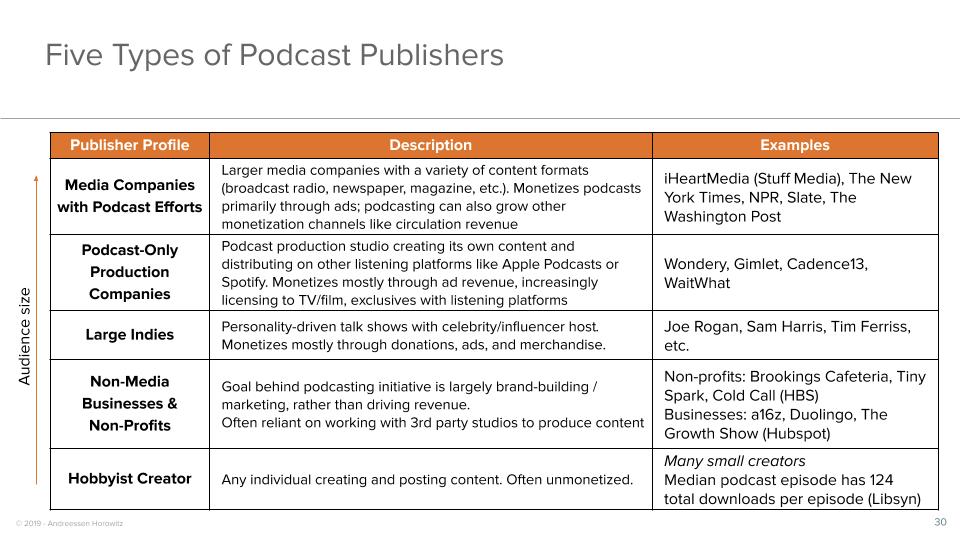 Seen as leaders, extroverted people will be more likely to lead than stand in the crowd and be seen to not be doing anything.
Seen as leaders, extroverted people will be more likely to lead than stand in the crowd and be seen to not be doing anything.
Agreeableness
People who exhibit high agreeableness will show signs of trust, altruism, kindness, and affection. Highly agreeable people tend to have high prosocial behaviours which means that they’re more inclined to be helping other people.
Sharing, comforting and cooperating are traits that lend themselves to highly agreeable personality types. Empathy towards others is commonly understood as another form of agreeableness even if the term doesn’t quite fit.
The opposite to agreeableness is disagreeableness but it manifests in behaviour traits that are socially unpleasant. Manipulation and nastiness towards others, a lack of caring or sympathy, a lack of taking interest in others and their problems are all quite common.
Agreeable people tend to find careers in areas where they can help the most. Charity workers, medicine, mental health and even those who volunteer in soup kitchens and dedicate time to the third sector (social studies) are high in the agreeableness chart.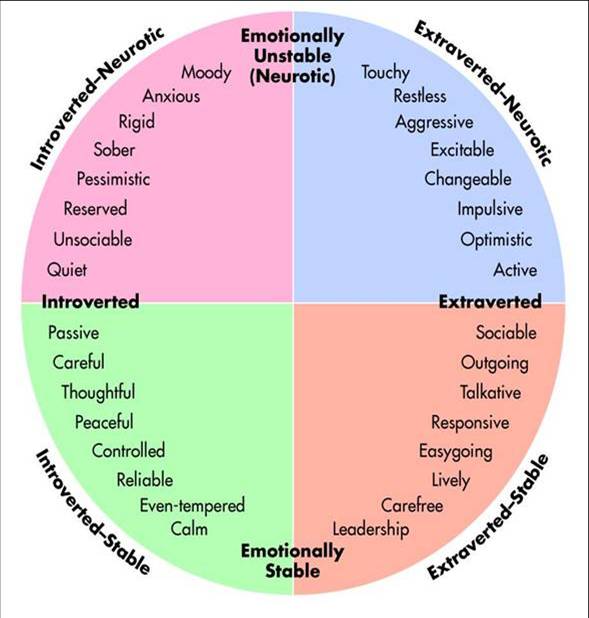
Neuroticism
Neuroticism is characterised by sadness, moodiness, and emotional instability. Often mistaken for anti-social behaviour, or worse a greater psychological issue, neuroticism is a physical and emotional response to stress and perceived threats in someone’s daily life.
Individuals who exhibit high levels of neuroticism will tend to experience mood swings, anxiety and irritability. Some individuals who experience sudden changes in character from a day-to-day perspective could be highly neurotic and respond to high stress levels in their work and personal lives.
Anxiety, which plays a large part in the makeup of neuroticism, is about an individual's ability to cope with stress and perceived or actual risk. People who suffer with neuroticism will overthink a lot of situations and find difficulty in relaxing even in their own space.
Of course, those who rank lower on the neurotic level will exhibit a more stable and emotionally resilient attitude to stress and situations.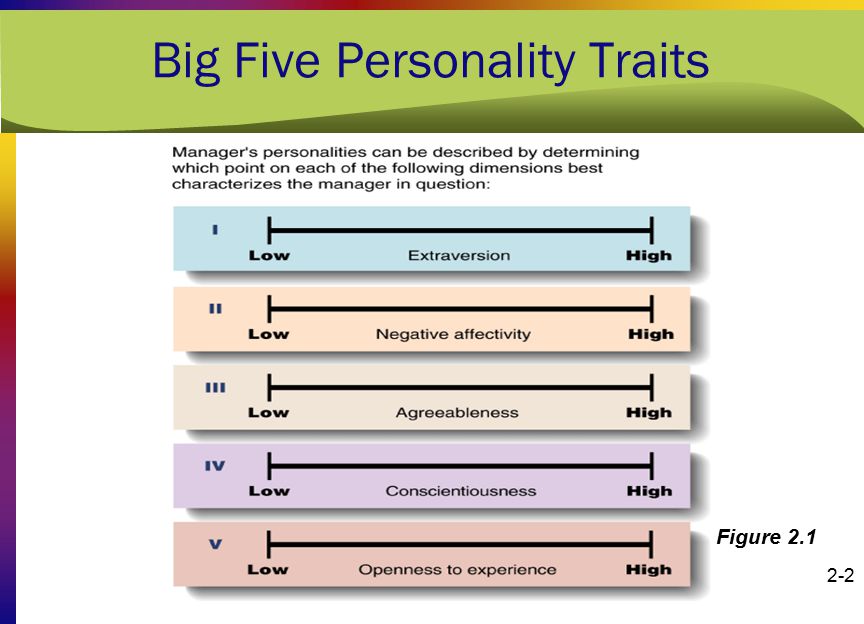 Low neurotic sufferers also rarely feel sad or depressed, taking the time to focus on the present moment and not get involved in mental arithmetic on possible stress-inducing factors.
Low neurotic sufferers also rarely feel sad or depressed, taking the time to focus on the present moment and not get involved in mental arithmetic on possible stress-inducing factors.
Who developed the big 5 personality traits?
Originally developed in 1949, the big 5 personality traits is a theory established by D. W. Fiske and later expanded upon by other researchers including Norman (1967), Smith (1967), Goldberg (1981), and McCrae & Costa (1987).
It’s suggested that as early the late 19th century social psychologists were trying to gain a more scientific understanding of personality but it wasn’t until the first official study in the 1930s by Gordon Allport and Henry Odbert that personality had some sort of scientific acknowledgement. They took 18,000 words from Webster’s Dictionary to describe personality traits and found adjectives that described non-physical characteristics creating a 4500 word bank of observable behaviour markers.
Later studies were able to identify many overlaps and specific traits per person which has allowed a more condensed and comprehensive review of personality traits.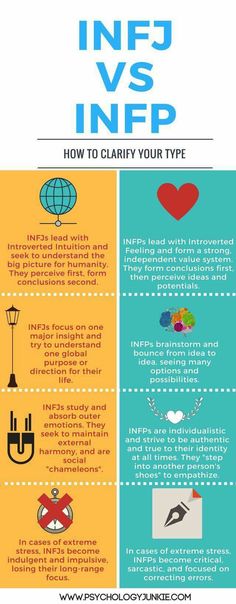 The big 5 are still widely used today as the basis of global study.
The big 5 are still widely used today as the basis of global study.
Why are the big 5 personality traits important?
When thinking about the big 5 personality traits, hiring managers, CEOs and even the candidates are wise to think about why they are important when it comes to joining a team. Before we go into the reasons why they are important, let’s quickly remind ourselves of what they are.
The five broad personality traits described by the theory are extraversion (also often spelled extroversion), agreeableness, openness, conscientiousness, and neuroticism.
The five basic personality traits is a theory coined in 1949 by D. W. Fiske (1949) and later expanded upon by other researchers including Norman (1967), Smith (1967), Goldberg (1981), and McCrae & Costa (1987).
So, why are they important when it comes to candidate selection?
The big 5 personality traits help us to not only better understand how they compare to others and to put names to their characteristics, it’s also used to explore relationships between personality and many other life indicators.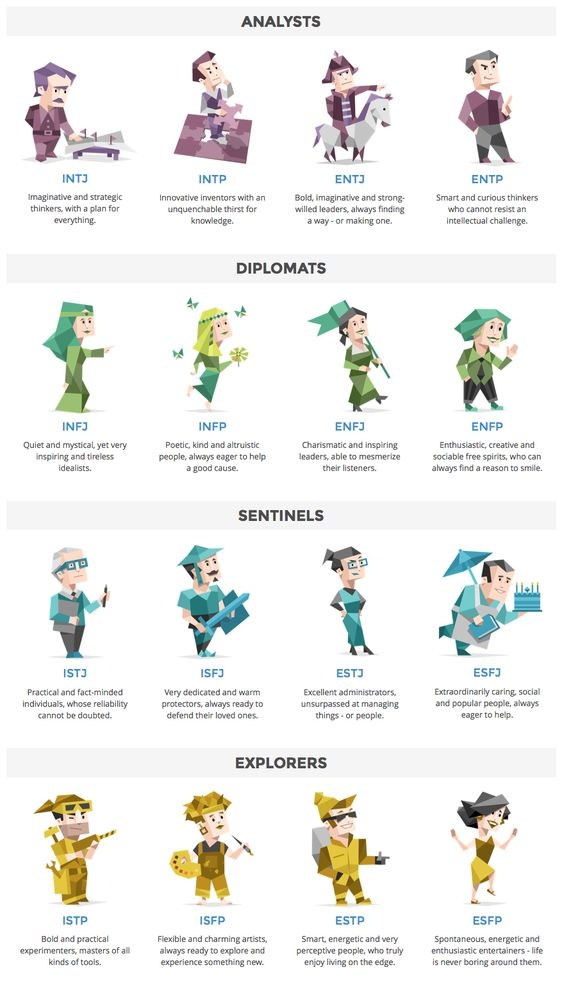
Think about knowing how agreeable your personality is and what this means to co-worker relationships? Or how neuroticism may have an impact on work-life balance? Overall, however, we can begin to break down why they’re important in different areas such as;
Understand employee relationships
How will people get along? Are you building a team where communication or trust may be stifled or open? Will you have a member of the team who can relate to others and be conscientious with others?
More effective team building and management
High five tendencies in openness, agreeableness and even extroversion can lead to better team management and team building. Someone who exhibits high agreeableness for example is capable of being cooperative, trustworthy and straightforward, making them easy to work with but also, showing the necessary skills for effective team management.
Understand employee motivations
Low five tendencies in something like extroversion can be difficult for understanding employee motivations.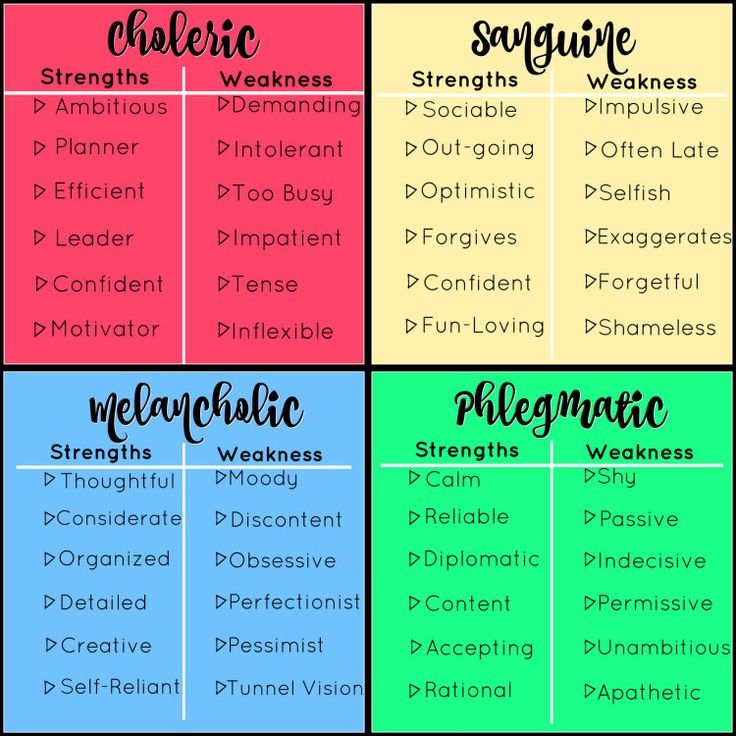 Whilst having a high-five tendency in agreeableness which encompasses empathy, makes it easier to get to the root causes of motivations and even gain a better understanding of people generally.
Whilst having a high-five tendency in agreeableness which encompasses empathy, makes it easier to get to the root causes of motivations and even gain a better understanding of people generally.
Build diverse teams
Something such as high-openness where embracing differences and embracing challenges can lead to more openness about who is hired, and finding solutions in different ways and areas. Whilst a team made up of mostly conscientious individuals is a team formation with the highest chance of being successful.
These teams will often display a good work ethic, produce high-quality work and be cooperative. This in return will lead to more solutions being put forward about who is required and where diverse teams can be built over time to help answer these problems.
Optimise interactions and communication
Again, something like high extroversion personality traits would be essential in developing interactions whilst being highly agreeable is better suited to open communications.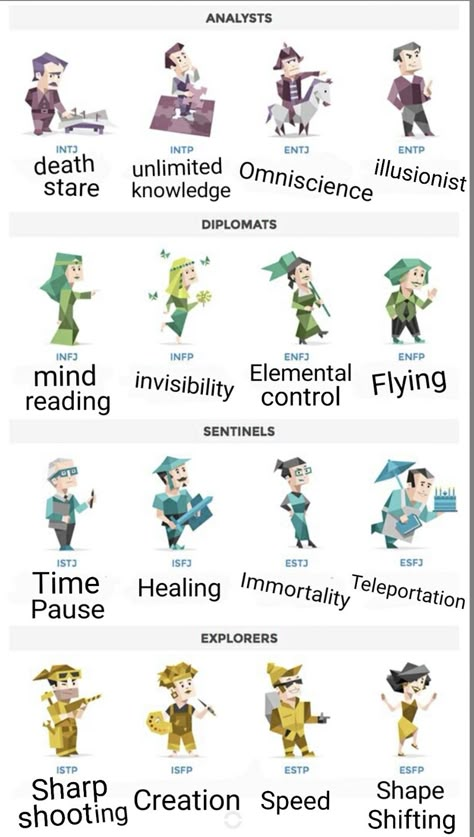
What factors influence the big 5 traits?
From nature and nurture to age and maturation, the big 5 traits have been widely studied where we can see what influences their impact on a person’s behaviour and character.
Personality has often been hypothesised as a question of nurture or nature. One particular study looked at 123 pairs of identical twins and 127 pairs of fraternal twins. “The findings suggested that the heritability of each trait was 53 percent for extraversion, 41 percent for agreeableness, 44 percent for conscientiousness, 41 percent for neuroticism, and 61 percent for openness.”
It has also been widely recognised that the older we get, the more our behaviour traits will change. We become less extraverted, less neurotic, and less open to new experiences whilst our agreeableness and conscientiousness will grow as we get older.
Do men and women differ with the big 5 traits?
The general consensus is that men and women are actually more alike than what normative social science would have us believe.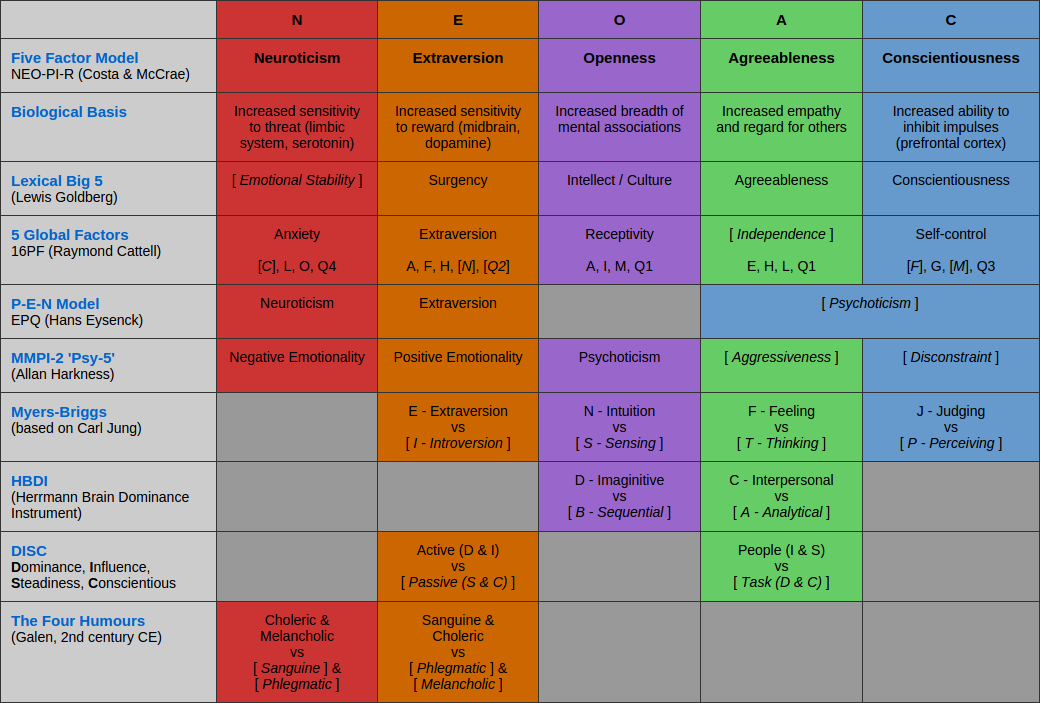 But as the title would suggest, there are some exceptions.
But as the title would suggest, there are some exceptions.
Weinsberg and DeYoung in 2011 studied the big 5 traits and in particular Gender Differences in Personality across the Ten Aspects of the Big Five. They concluded that women tend to score higher on Extraversion, Agreeableness, and Neuroticism than men.
Other studies have concluded that whilst the differences may be present, some traits are not extensively separate. Getting older will tend to align behaviour traits such as agreeableness and extraversion where both genders tend to score lower as time moves on.
Which big 5 personality types make the best leaders?
If you’re looking to build a great leader, then you need to consider the importance of the big 5 model as it will give you all the tools you need to understand where the leaders in your organisation may secretly be hiding.
For example, you may think that an extrovert may be a good leader. Although extraverts tend to show good leadership skills, be sociable and encourage discussions, research has suggested that too many extroverts in a team can actually cause a decrease in effectiveness.
Whilst extroversion is typically the strongest characteristic, followed by conscientiousness, openness to experience, neuroticism and finally agreeableness being the least common, you want to think about what makes a good leader.
For example, conscientiousness, or self-discipline, is one of the most important factors in a leader, particularly under stressful situations when responsibility and reliability is pertinent.
What you get with a conscientious leader is someone who is diligent over individual tasks, and will stay with them until completed and therefore, trust is put in their direction as someone who is reliable. Something like being a reliable individual is also closely related to intelligence on the matter at hand. While there may be many other forms of intelligence that the individual may lack, knowledge about the relevant situation is key.
Openness to experience is important when leading a team. Leaders will find themselves in situations that are out of their hands, a constantly evolving situation where if there is an unexpected issue or there is something coming down the pipeline, their ability to take executive decisions is only a positive. There is also a level of creativity that comes with openness and in difficult situations or confusing times, a resourceful leader - usually high in openness is a benefit.
There is also a level of creativity that comes with openness and in difficult situations or confusing times, a resourceful leader - usually high in openness is a benefit.
The two of the big 5 least attractive to leadership roles are neuroticism and agreeableness. The former will find teams being led by someone unsure of the decisions being made and potentially worse, being scared about the decision being made so no decision is made at all. The latter may have more people skills but that doesn’t mean that they have leadership traits. They may find themselves pleasing people rather than actually keeping the task in mind.
One of the key components to all of this however is that the Big 5 is not definitive and does not mean leaders can be predicted based on personality types. Other factors are far more important to appointing and training leaders, but this is a helpful exercise for those looking to reach leadership positions.
Big 5 personality traits tests
We can successfully measure personality traits with different tools and techniques.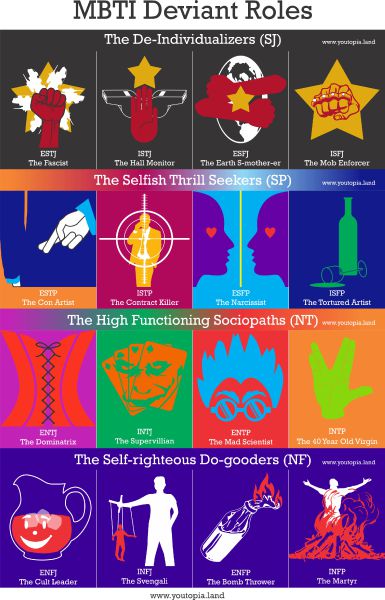 All in all, these tests are trying to discover how much your behaviour varies from high to low in the five traits which include; Openness, Conscientiousness, Extraversion, Agreeableness and Neuroticism.
All in all, these tests are trying to discover how much your behaviour varies from high to low in the five traits which include; Openness, Conscientiousness, Extraversion, Agreeableness and Neuroticism.
How are the traits measured?
Traditionally, a big 5 personality test is taken with a questionnaire and a multiple choice response.
For example, these questions will ask how much a person agrees or disagrees that he or she is someone who exemplifies various specific statements, such as:
- “Is open to trying new experiences” (for openness, or open-mindedness)
- “Is always thinking about others” (for conscientiousness)
- “Is the centre of attention at a party” (for extroversion)
- “Is trusting of others” (for agreeableness)
- “Is anxious about the future all the time” (for neuroticism, or negative emotionality)
The responses, Strongly agree to Strongly Disagree (with alternatives in between) will determine to what scale the person may be grouped into different personality traits.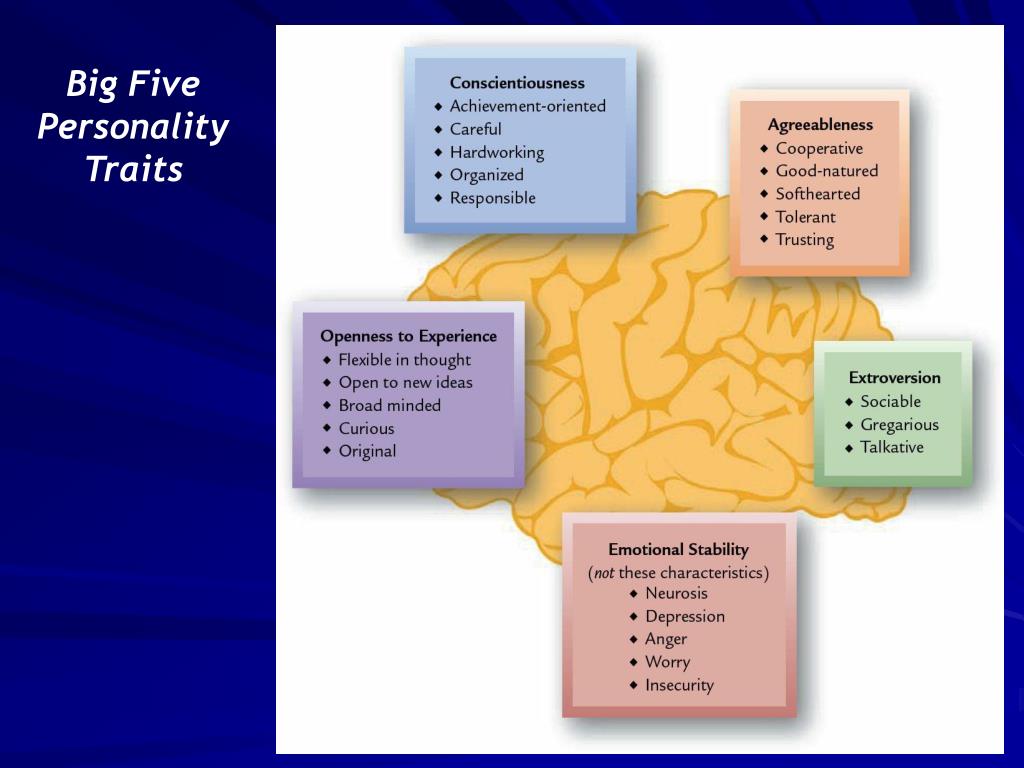
Are big five personality tests reliable?
Assessments based on the big 5 personality tests are very reliable, provided that sufficient research has been carried out and substantiated.
It is, to date, the most scientifically validated and reliable psychological model to measure personality. It is used to help predict behaviour as well as personality.
It remains a dependable model that businesses and scientific studies have been able to use consistently over a long period of time in helping to create new models, which predict someone’s behaviour at work, response to stressful situations and even understanding aspects of recorded social studies.
How do the big five personality traits predict behaviour at work?
When hiring employees (or testing current ones), the big 5 personality traits help us understand behaviour in the workplace and accurately predict, in many cases, future performance. Each personality type will have an impact within the working environment and amongst other staff. Being able to identify where there could be a positive or negative impact can help influence decisions around hiring or retaining staff.
Being able to identify where there could be a positive or negative impact can help influence decisions around hiring or retaining staff.
A candidate with a high openness score would be willing to learn new skills and tools. Presented with more abstract problems, they are more likely to think of abstract solutions and would be focused on tackling new problems that were perhaps previously overlooked.
Candidates with a high conscientiousness score wouldn’t necessarily be sat at their desk until midnight every evening! They would however be keen to get their work done, meet deadlines and be a self-starter; requiring little hand-holding to get the task done. Someone scoring low on the other hand, would need a lot more focus, time and attention to the task at hand.
The ideal extraversion scores would depend on the role you’re hiring for. Seen by many to be leaders in a team, a high extraversion score would do well in environments where they thrive off interaction with others:; sales, marketing & PR all require a level of people- facing skills.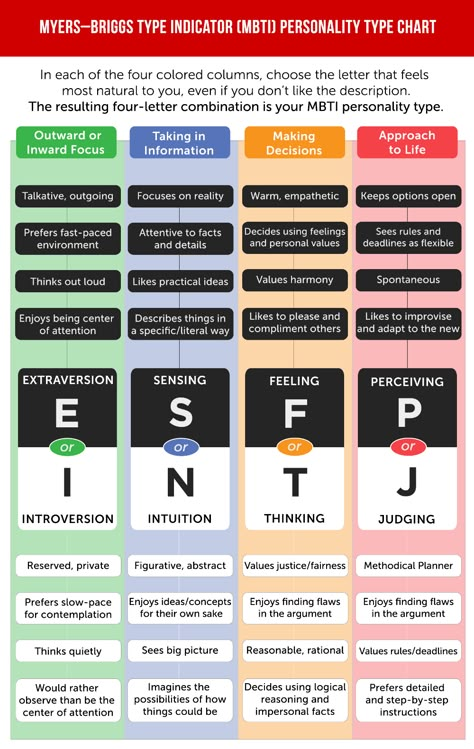 More technical job setups where specific focus or a degree of isolation is needed would, however, not be a good fit.
More technical job setups where specific focus or a degree of isolation is needed would, however, not be a good fit.
A candidate who shows high agreeableness would suit a role where personal skills and an ability to be at the service of others are needed. Of course, the opposite would be bad in a strong team environment and cause significant issues in order to work towards a common goal or task.
Finally, a candidate who exhibits high neuroticism will not be suited to a role where there are consistent changes, tasks that require strong self-starter tendencies or high stress levels. Those with low neuroticism scores will, however, thrive in these kinds of workplace scenarios.
These traits help us to understand how we may behave in the future, in our workplace and under certain circumstances as. For businesses, they can identify future talent, derailers and even potential for success.
How can Thomas help you find the right person for your role?
The Thomas Workplace Personality Test covers areas of personality testing based on Big 5 theory.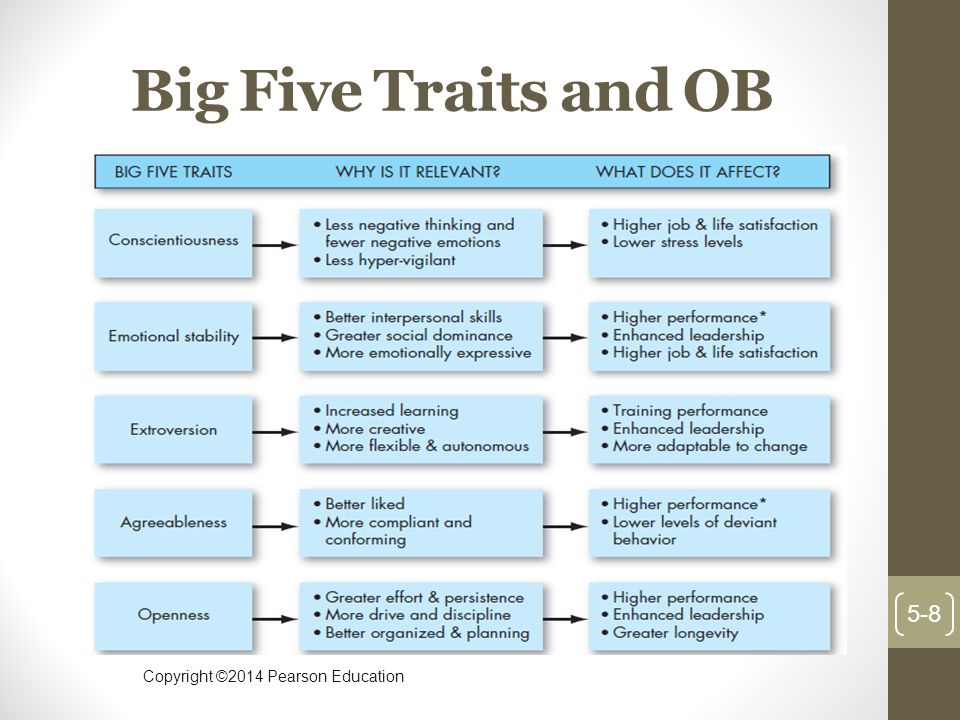 Also known as the High Potential Trait Indicator (or HPTI), it provides valuable insight into a person's strengths and potential derailers, including their leadership potential.
Also known as the High Potential Trait Indicator (or HPTI), it provides valuable insight into a person's strengths and potential derailers, including their leadership potential.
Developed by Ian MacRae and Adrian Furnham in 2006, the HPTI has been designed based on an ‘optimality’ model, which assumes that personality traits can be considered ‘optimal’ based on the requirements of a particular job role or position, such as senior executive leadership.
Based on a self-report questionnaire, the answers have 7 levels of agreement on a 1-7 Likert scale (1 ‘disagree completely’ to 7 ‘agree completely) with 78 unique items, and the test takes as little as 8 minutes to complete.
If you are interested in finding out more about how our Workplace Personality assessment can help you and your business, please speak to one of our team.
Free Big Five Personality Test
AS SEEN IN
Recent Reviews
by Drish
Whew! I am truly blown away by the accuracy of my results.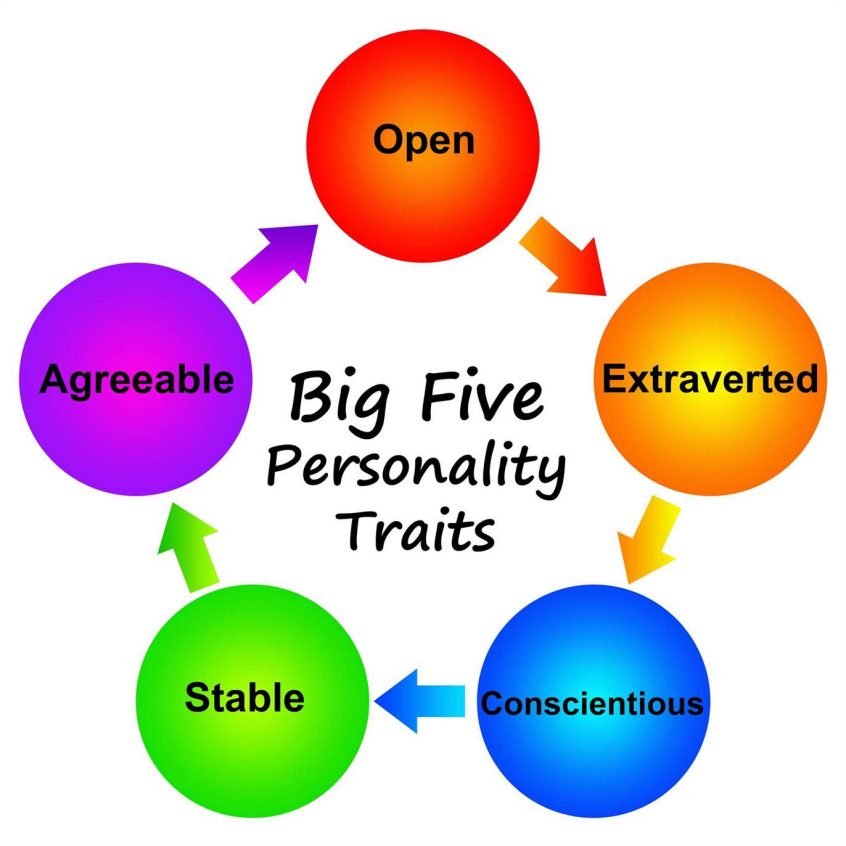 It made me appreciate aspects of myself that I may downplay or may think of negatively, but it also got me to realize many of my shortcomings in a nuanced way. I’m not gonna lie, some of it was hard to read! I mean—who wants to think of themself as highly disagreeable or neurotic?? There were moments where I felt downright naked! Like this test was somehow peering straight through me. Lastly, I liked that it did not attach morality to these aspects of personality. Instead, it explored possible three-dimensional realities a person may experience as a result of their unique blend of patterns of thought and behavior. Honestly not mad at the money I spent lol (no, this is not a sponsored review, I just think truity is a dope site). I really enjoyed their Enneagram test as well! If you take this test with an open mind and really try to be objective in your answers, I definitely think you will learn a thing or two about yourself. Also they have coupons!
It made me appreciate aspects of myself that I may downplay or may think of negatively, but it also got me to realize many of my shortcomings in a nuanced way. I’m not gonna lie, some of it was hard to read! I mean—who wants to think of themself as highly disagreeable or neurotic?? There were moments where I felt downright naked! Like this test was somehow peering straight through me. Lastly, I liked that it did not attach morality to these aspects of personality. Instead, it explored possible three-dimensional realities a person may experience as a result of their unique blend of patterns of thought and behavior. Honestly not mad at the money I spent lol (no, this is not a sponsored review, I just think truity is a dope site). I really enjoyed their Enneagram test as well! If you take this test with an open mind and really try to be objective in your answers, I definitely think you will learn a thing or two about yourself. Also they have coupons!
by Ruben P
Reading my Big Five Report was like staring at a personality mirror! It accurately reflects my personality traits and provides insights about how the combination of these traits create patterns of thought and behavior that drive the way I think and live.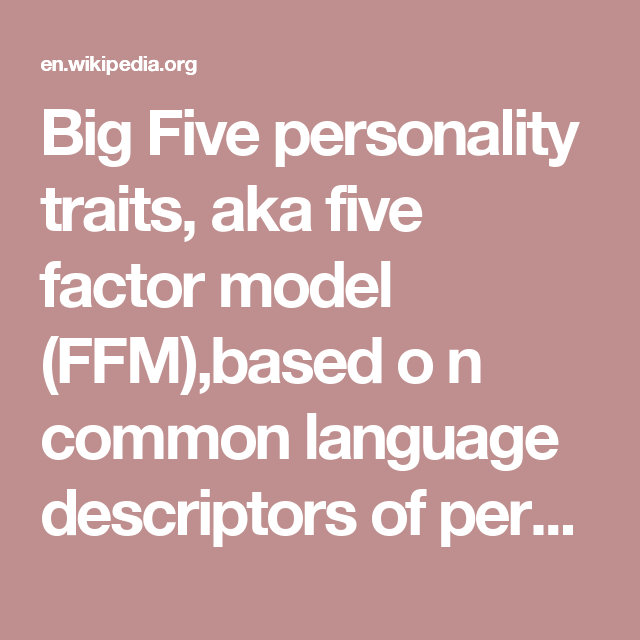 Pretty powerful stuff and I would recommend this for anyone wanting to understand their own personality traits more deeply.
Pretty powerful stuff and I would recommend this for anyone wanting to understand their own personality traits more deeply.
by Kaden
This test has been very insightful and offers different perspectives- I have taken both the Myers Briggs and the Enneagram and this test offers deeper insight in to the science behind specific personality traits which I really appreciate. I highly recommend this test for anyone who is looking to understand more about themselves, specifically about how their traits contribute to their relationships with themself and others.
Previous
Next
Big Five Personality Test FAQ
Q. What is the Big Five personality test based on?
A.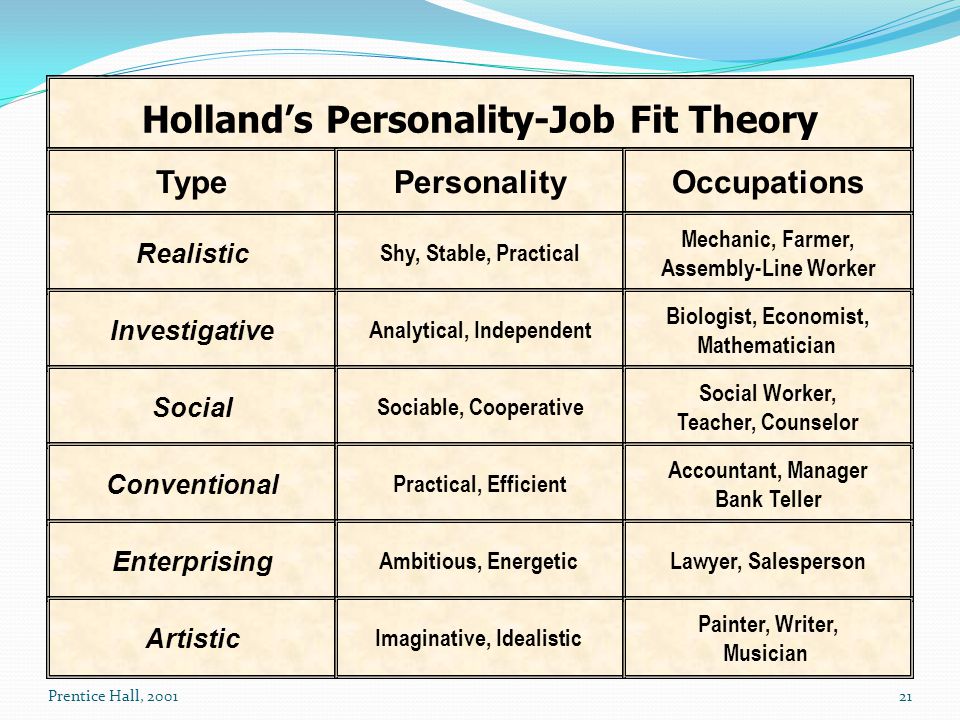 The Big Five personality test is a comprehensive personality inventory based on decades of psychological research. Psychologists and academic researchers investigating the fundamental traits of personality found repeatedly that people's personality differences naturally sort into five broad dimensions, referred to as the Big Five.
The Big Five personality test is a comprehensive personality inventory based on decades of psychological research. Psychologists and academic researchers investigating the fundamental traits of personality found repeatedly that people's personality differences naturally sort into five broad dimensions, referred to as the Big Five.
Today, the consensus among the scientific community is that human personality is most accurately described in terms of these Big Five personality traits. The Big Five model of personality is widely considered to be the most scientifically valid way to describe personality differences and is the basis of most current personality research.
Q. What are the Big Five personality traits?
A. The "Big Five" or Five Factors refers to the five major personality dimensions that psychologists have determined are core to our individual makeup. The Big Five personality traits are:
- Openness - How open a person is to new ideas and experiences
- Conscientiousness - How goal-directed, persistent, and organized a person is
- Extraversion - How much a person is energized by the outside world
- Agreeableness - How much a person puts others' interests and needs ahead of their own
- Neuroticism - How sensitive a person is to stress and negative emotional triggers
Each of the Big Five personality traits is considered to drive a significant aspect of cognition (how we think) and behavior (how we act). Each trait is completely distinct and independent of the other four traits; for instance, a highly Extraverted person is no more or less likely to be highly Conscientious as well.
Each trait is completely distinct and independent of the other four traits; for instance, a highly Extraverted person is no more or less likely to be highly Conscientious as well.
For an individual, each of the Big Five personality traits is measured along a spectrum, so that one can be high, medium, or low in that particular trait. This makes the Big Five model distinct from many pop psychology systems that classify people in terms of personality "types." In the Big Five framework, rather than being sorted into types, people are described in terms of how they compare with the average across each of the five personality traits.
Q. How long is the Big Five test?
A. The test consists of 60 questions and takes about 5-10 minutes to complete.
Q. What will my Big Five test results look like?
A. You will first see a brief, free report showing the basic findings of your personality test. Then, you have the option of unlocking your full report for a small fee.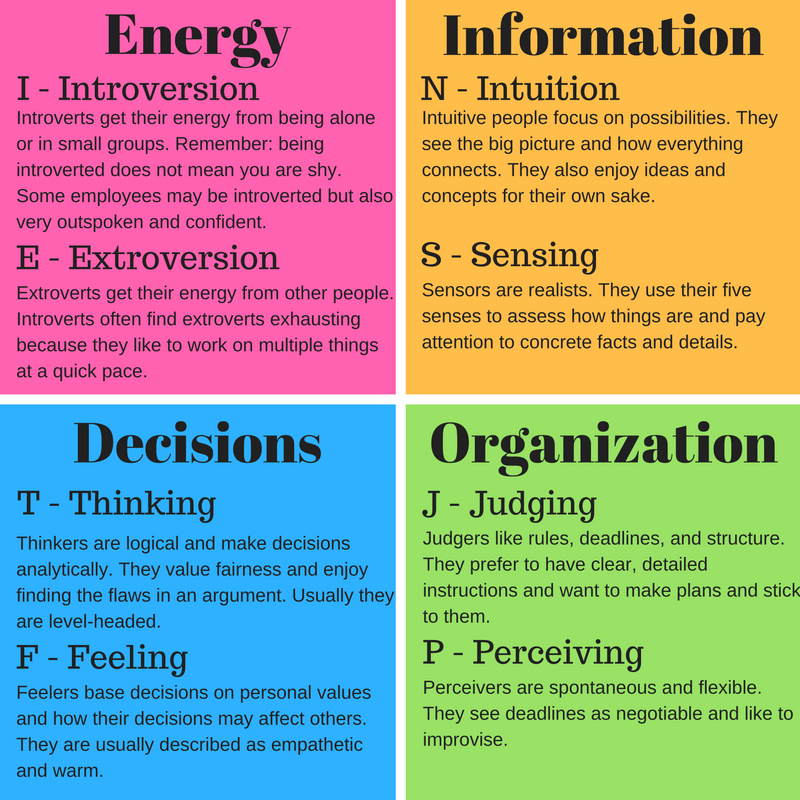 To see what you can expect from your full report, check out this sample Big Five report.
To see what you can expect from your full report, check out this sample Big Five report.
Q. How can I access my Big Five personality test results?
A. After you take a test, you will have the option to create an account by entering your email address. If you create an account, you can view your test results at any time by returning to Truity.com and logging into your account. We do not email your results to you.
Q. Do I need to complete this personality test all at once?
A. If you’ve created an account, you can click on ‘Save’ at the bottom of the screen, and your responses will be saved. If you do not log in to a Truity account before starting the test, you won't have the option to stop and save your responses and will need to complete the test all at once.
Q. Is this personality test really free?
A. You do not need to purchase or register to take this test and view an overview of your results. If you would like, you can purchase a more comprehensive full report for a small fee.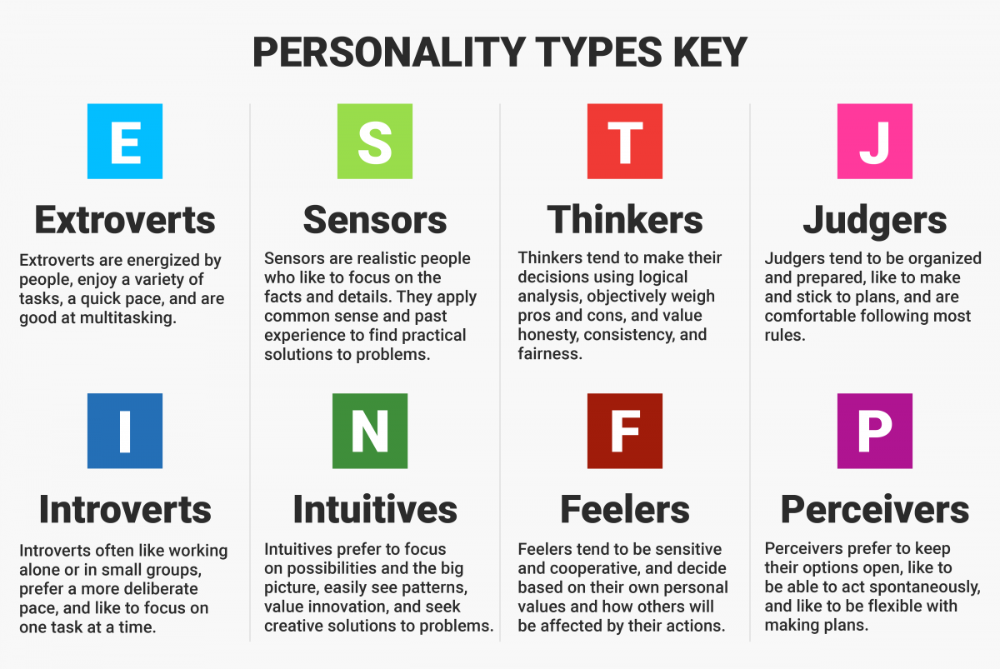
Q. Is this Big Five personality test accurate?
A. This test has been researched extensively to ensure it is valid and reliable. It is based on psychological research into the core of personality and Truity’s psychometric research. Your scores show you how you compare to the other people in a large, international sample for each of the Big Five personality traits.
Q. Can I have my employees, team or group take the Big Five test?
A. Absolutely. Our Truity @ Work platform is designed to make it easy to give the Big Five personality test to your team or group. See discounted group pricing and learn how to quickly and easily set up testing for your group on the Testing for Business page.
Q. What is the difference between Big Five, Five Factor, and the OCEAN model of personality?
A. Big Five, Five Factor, and OCEAN are all ways of describing the same theory of personality. Multiple psychological studies have arrived at the conclusion that the differences between people's personalities can be organized into five broad categories, called the Big Five or Five Factors. These are sometimes referred to as the five broad dimensions of personality.
These are sometimes referred to as the five broad dimensions of personality.
Q. Are you going to sell my data?
A. . We do not sell your email or other data to any third parties, and we have a zero-spam policy. We carefully comply with applicable privacy laws in handling your personal information. You can read more in our privacy policy.
People were divided into four types of personality
American psychologists have proposed a new personality typology. After analyzing the scores of more than 1.5 million people who took part in the Big Five Trait Survey, the researchers identified four personality types: "normal", "introverted", "egocentric" and "role model". Article published in Nature Human Behavior .
Psychologists identify five main characteristics of a person's personality (they are also called the "Big Five"): extraversion, agreeableness, conscientiousness, neuroticism and openness to experience. Individual differences in these characteristics largely predict human behavior in the social environment and its adaptation to changes in the surrounding world.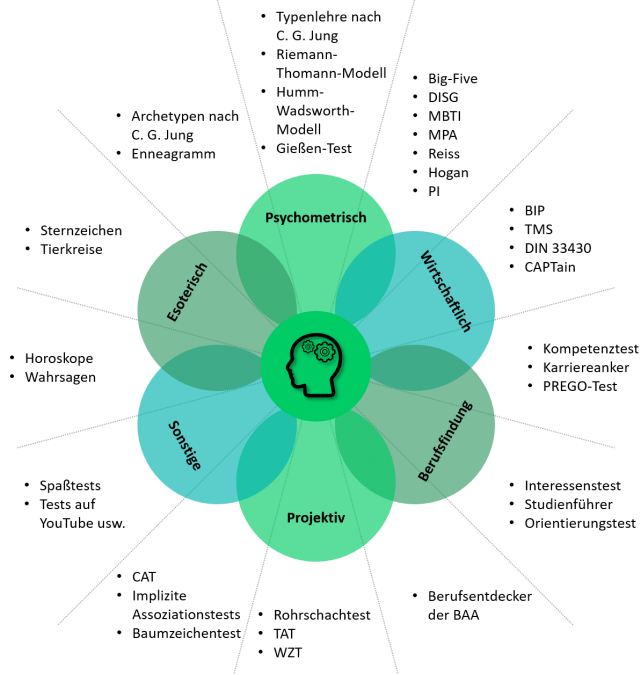
Based on these five characteristics, one can effectively study the personality typology, highlighting, for example, several basic types of a person's character. Many of the attempts made so far, however, have an important limitation due to the small sample, which makes it impossible to generalize the conclusions and apply the results to the entire population: this is inefficient, for example, from an anthropological point of view, because it poorly takes into account the influence of various cultural factors.
American psychologists at Northwestern University, led by Luís A. Nunes Amaral, decided to approach the matter more systematically. To do this, they analyzed four datasets, each of which contains data on several (from 100 to 500) thousand people. Scientists managed to collect a diverse sample, which totaled more than one and a half million men and women of different ages from different countries.
For each participant in the sample, information was available on the characteristics of the Big Five.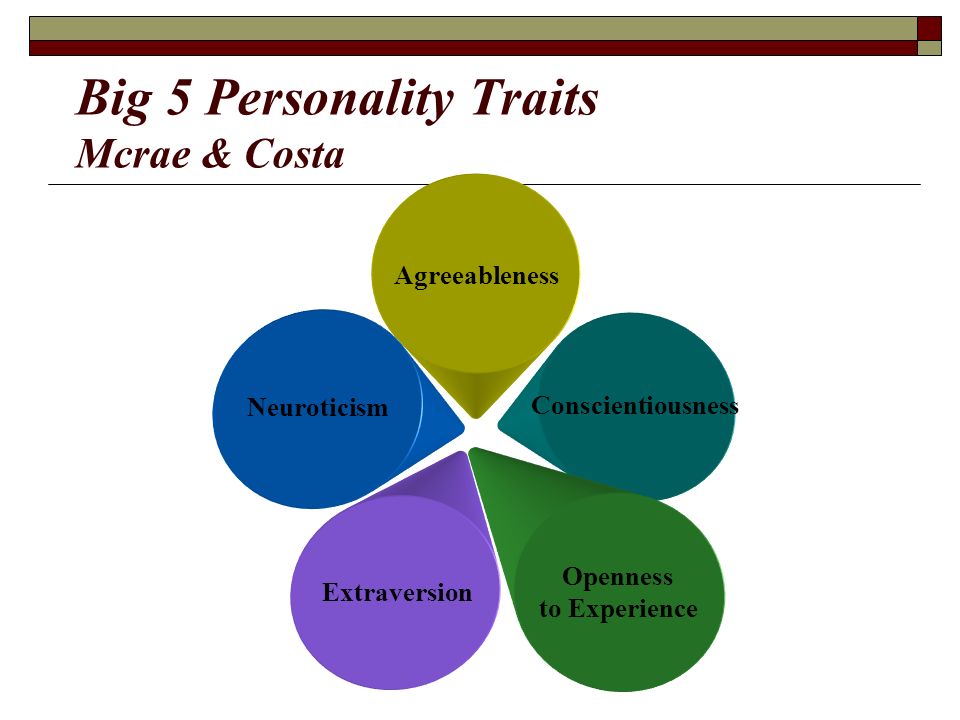 After examining the results, the researchers clustered each characteristic by z-score from -1 to 1. It turned out that four types of personality can be distinguished based on the distribution of scores. The first type, "normal" (or "usual", average) is characterized by high rates of neuroticism and extraversion and low - openness to experience. The second type, "closed" (reserved), was distinguished by low neuroticism and openness, as well as average indicators of consciousness and goodwill. The third type was referred to as "egocentrics" (self-centred): they had increased extraversion, and all other indicators were below average. Finally, the fourth type was called "role models" (role model): they scored high on all characteristics except neuroticism.
After examining the results, the researchers clustered each characteristic by z-score from -1 to 1. It turned out that four types of personality can be distinguished based on the distribution of scores. The first type, "normal" (or "usual", average) is characterized by high rates of neuroticism and extraversion and low - openness to experience. The second type, "closed" (reserved), was distinguished by low neuroticism and openness, as well as average indicators of consciousness and goodwill. The third type was referred to as "egocentrics" (self-centred): they had increased extraversion, and all other indicators were below average. Finally, the fourth type was called "role models" (role model): they scored high on all characteristics except neuroticism.
The scientists also examined what demographic indicators affect the fact that a person will relate to a particular type of personality. Thus, it turned out that “role models” are more often women, and the number of “egocentrics” grows with age.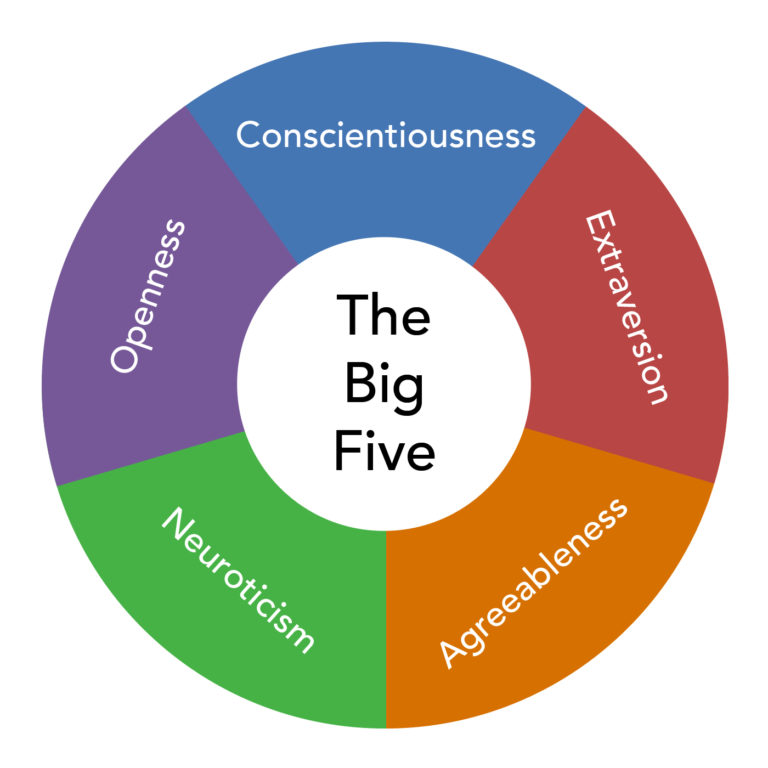
The authors, however, note that their study, although it has relatively high statistical power, has some limitations: for example, there are few adolescent boys in the sample. Transferring the results to the entire population, therefore, should be done with caution. In addition, the validity of the method should be checked further - on other samples that are suitable in size.
Despite the fact that the character of a person changes with age, the personality remains stable: this is the conclusion recently made by scientists who have studied the personal characteristics of people for 50 years.
Elizaveta Ivtushok
Found a typo? Select the fragment and press Ctrl+Enter.
5 personality types in psychology, their description and compatibility
There are many quizzes and tests on the Internet that claim to help in determining the personality types of a person.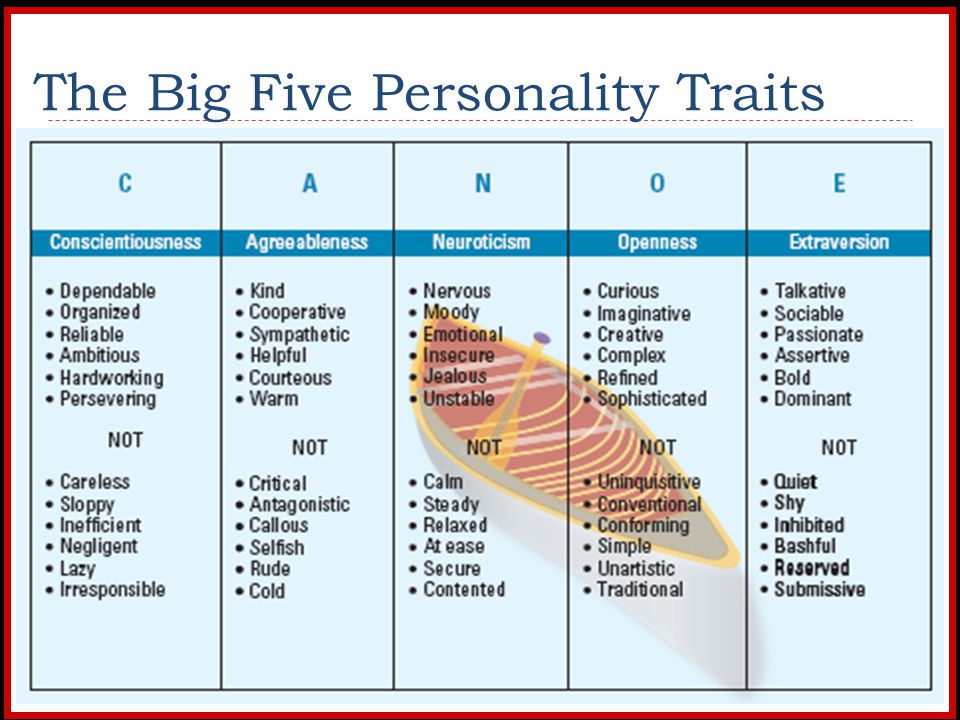 Unfortunately, most of them are not based on any scientific research, and if you come across a system that claims to divide the whole of humanity into just a few categories, it's safe to say that it is probably oversimplified.
Unfortunately, most of them are not based on any scientific research, and if you come across a system that claims to divide the whole of humanity into just a few categories, it's safe to say that it is probably oversimplified.
So what are the types of human personality? Well, in fact, rather than trying to classify people into "types," psychologists tend to focus on personality traits. Each of them manifests in a certain spectrum, and they are independent of each other, creating an endless constellation of human individualities.
Below we will consider the most popular personality models and dwell on the one that reflects the perception of people by each other.
Big five personality traits
Photo by Anna Shvets, pexels
This model was developed in the 1970s by two American research teams led by Paul Costa and Robert R. McCray of the US National Institutes of Health, and Warren Norman and Lewis Goldberg of the University of Michigan and Oregon State University.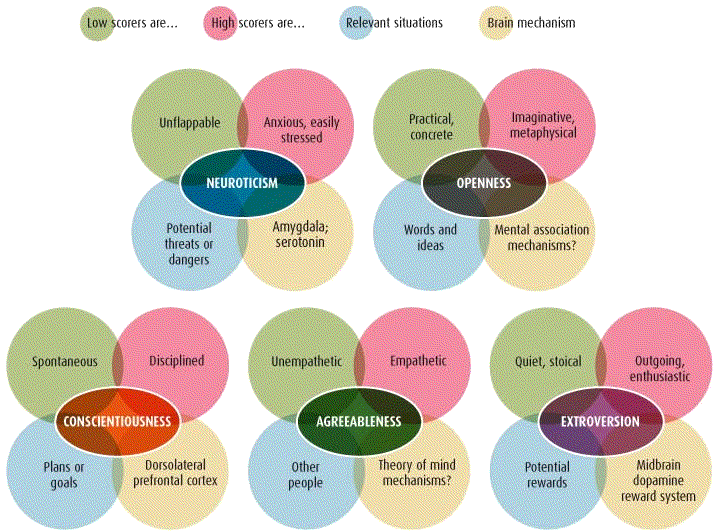
In the Big Five, the researchers included such independent features (dispositions) as:
- openness to new experience;
- conscientiousness;
- extraversion;
- goodwill;
- neuroticism.
Tests and peer reviews are used to derive the Big Five model, and behavioral data collection is used in research.
Domestic researchers A. G. Shmelev and V. I. Pokhilko confirmed that the data given in the Big Five are sufficient to compile a full-fledged psychological type of personality. This model has been adapted for a test called 5PFQ - it is easy to find it on the Internet in an online format.
Now let's look at the description of personality types in the Big Five.
Openness to new experiences
Among those with a high level of openness to new experiences are adventurers and adventurers. These people are usually very inquisitive, have a rich imagination and love experiments.
In contrast, people with a low level of openness are true conservatives. They do not like change and prefer to stick to monotony in their routine and diet, staying true to their habits.
They do not like change and prefer to stick to monotony in their routine and diet, staying true to their habits.
Conscientiousness
Conscientious (or conscientious) people are organized, reliable, disciplined and focused on achieving their goals. If they go on a trip around the world, you can be sure that their route will be thoroughly planned, and finances calculated with a margin.
On the other hand, people with a low level of conscientiousness are more spontaneous and liberated. They can be a little careless and often lose things.
Extraversion
Photo by Wendy Wei: Pexels
Extraversion and its opposite, introversion are perhaps the most recognizable personality traits of the Big Five, and you've probably heard of them before.
Extroverts are sociable guys who easily find a common language with almost any person, love communication and draw energy from being in the crowd. They tend to be assertive and cheerful in their social interactions.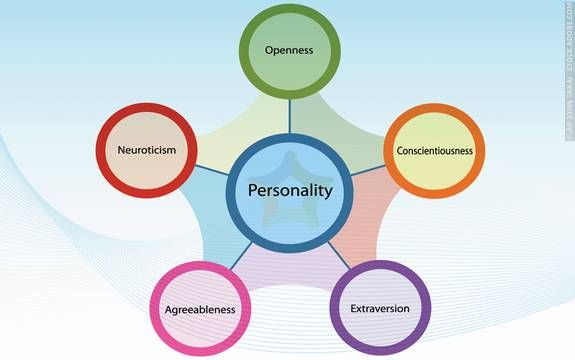
Introverts, on the other hand, prefer to spend time alone. Because of this, introversion is often confused with shyness, but they are not the same thing. Shyness implies a fear of social interactions or an inability to function in society. Introverts, on the other hand, can be real stars at parties - they just prefer more intimate ones to large gatherings.
Goodwill
This disposition measures the degree of warmth and kindness of a person. The more benevolent a person is, the more likely he is to trust, help, and sympathize with those around him.
With a low level of goodwill, people are more cold and suspicious of others, less inclined to cooperate.
Neuroticism
Photo by Andrea Piacquadio, pexels
People with a high level of neuroticism often worry about everything in a row, experience feelings of anxiety and easily become depressed. Even if everything is going well, neurotic people still find something to worry about.
Do not miss
-
Do not miss
All on the nerves: symptoms of neurosis in women, men, adolescents and children
One 2012 study found that when neurotic high-paying people get a raise, the extra income makes them... less happy! Since people with a high level of neuroticism tend to experience a lot of negative emotions, it plays a role in the development of emotional disorders.
On the other hand, people with a low level of neuroticism tend to be emotionally stable and balanced.
Can a person change?
A study published in the Psychological Bulletin in January 2017 summarized 207 scientific papers and showed that personality can be changed through therapy.
“If you choose to focus on one aspect of yourself and are willing to do it systematically, we hope you can influence change in that area.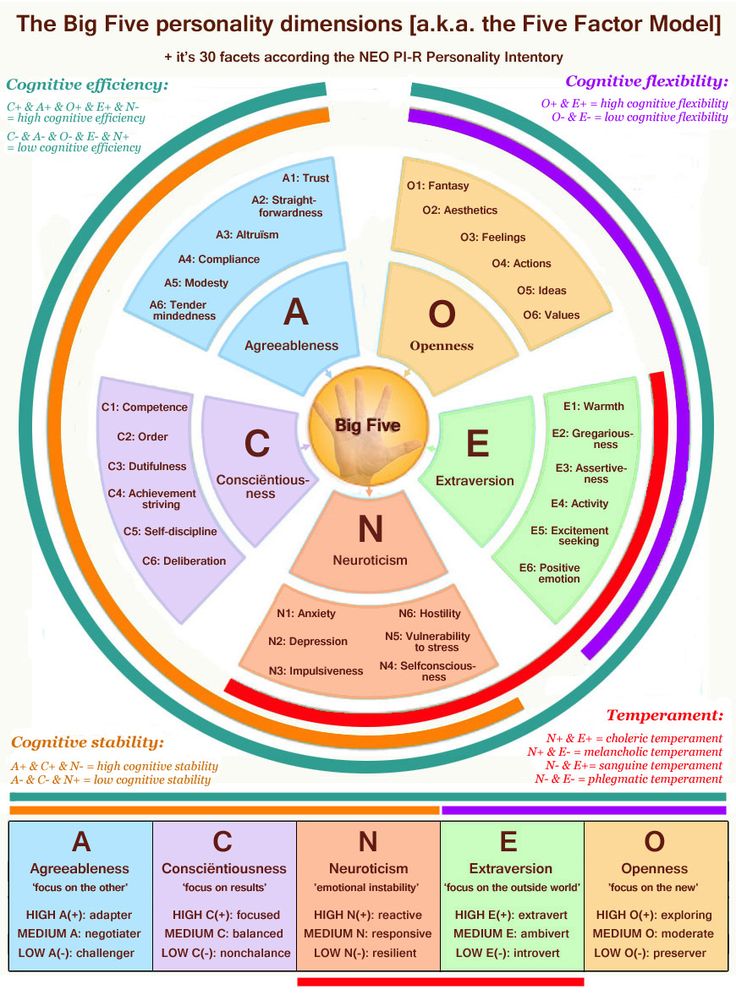 ” ,” said researcher Brent Roberts, a social and personality psychologist at the University of Illinois.
” ,” said researcher Brent Roberts, a social and personality psychologist at the University of Illinois.
Because neuroticism has been associated with mental health problems, researchers have recently become interested in trying to reduce it through therapy. It is hoped that targeting the level of neuroticism will prevent the development of disorders such as depression.
Don't miss it
Personality also seems to change - slowly but naturally - throughout a person's life. Thus, with age, some people become more extroverted, less neurotic, more agreeable, and more conscientious. Or vice versa, it depends on the person.
From the Enneagram to the Myers-Briggs Typology: Other Popular Personality Typologies
Photo by Jessica Lynn Lewis, pexels
While the Big Five is by far the most researched and scientifically validated model, there are other personality typologies. They are not always authentic like the Big Five, but they are entertaining and some people find them useful for reflecting on their qualities and goals.
Therefore, if you come across a test on the Internet that offers to identify a personality type by blood type or zodiac sign, or promises to determine the compatibility of personality types, you should not take its results too seriously.
Now let's talk about the most popular and authoritative typologies.
Myers-Briggs Typology
This tool categorizes people into 16 "types" based on four scales.
Orientation of consciousness (E-I scale)
Orientation of consciousness outward (extraversion) or inward (introversion).
Method of orientation in a situation (S-N scale)
Orientation to material information (facts) or intuitive (feelings).
Decision-making basis (T-F scale)
Logical weighing of alternatives or decision-making based on emotional ethics.
Way of preparing decisions (J-P scale)
Rational preference for planning and ordering information in advance or irrational preference for acting impulsively, guided by circumstances.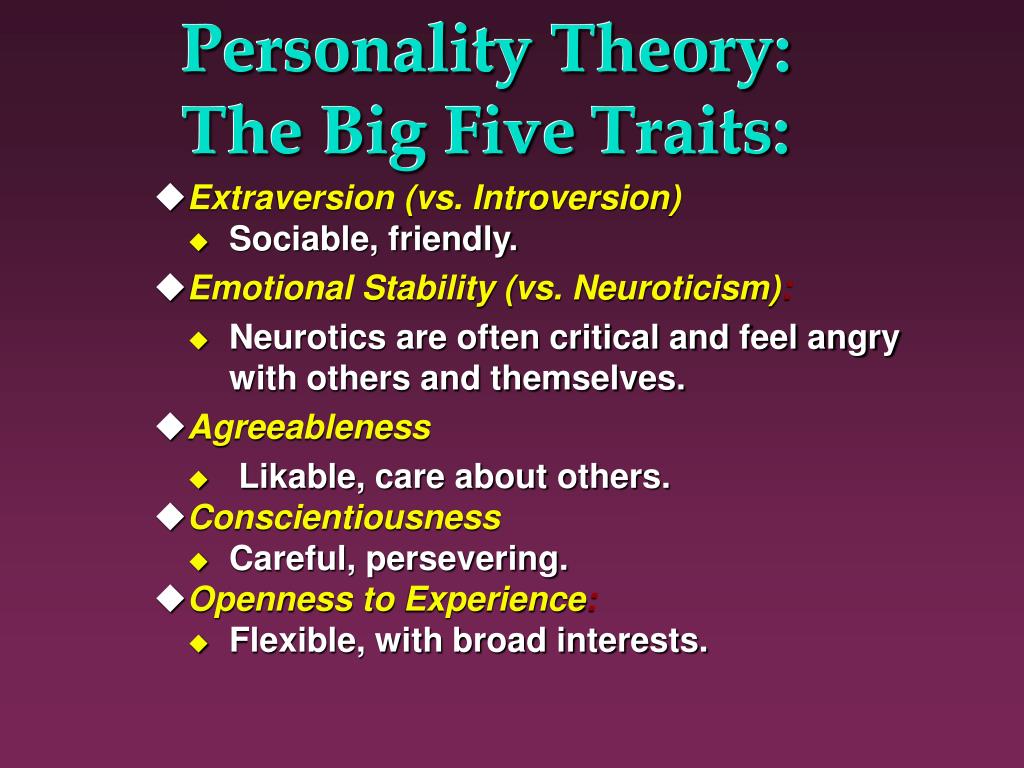
Although this typology is quite popular, studies have shown that it is not very reliable. For example, people often get different answers if they take the test multiple times, and the answers often do not correspond to the actual behavior or performance of survey participants.
Enneagram
Photo by Armin Rimoldi, pexels
Another popular test is the Enneagram, which divides people into nine personality types, with additional enneatypes covering other traits that people may sometimes display.
However, the Enneagram is not based on scientific theory, and very little research has been done to show how reliable it is.
16-factor personality questionnaire
This technique, which can often be seen online, is based on the Myers-Briggs typology and divides people into 16 categories according to their social qualities, highlighting, for example, such groups as “diplomats” and “researchers”.
Researchers note that this test gives a more accurate prediction than the "Big Five" only if it is based on the results of a factor analysis performed in the country in which this test is intended to be carried out.